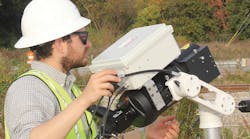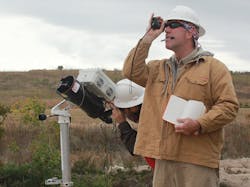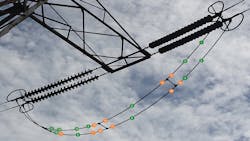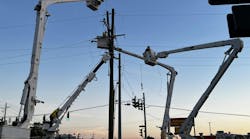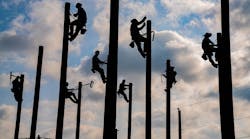Electric utilities nationwide are investing significant capital in reconductoring aging lines. A new technology invented by the Electric Power Research Institute (EPRI), however, could change the way utilities view inspections and conductor repairs and replacements.
While conductors may start to show signs of age the longer they are in service, not all of them need to be repaired or replaced immediately. By measuring the level of corrosion in the aging conductors, utilities may find that certain sections of line may be set to perform for another 30, 40 or even 50 years.
When linemen detect an anomaly on a power line, they often take an emergency power outage to make the repair or replace the conductor. In many cases, corrosion may be the culprit. Over time, environmental conditions, including moisture, impact the conductors’ steel support causing the formation of rust and iron oxide. The resulting corrosion can compromise the strength and competency of overhead lines, leading to power-quality and reliability issues.
“We are still understanding how the environment and the construction standards interplay,” says Neal Murray, a principal technical leader in EPRI’s transmission research and development group. “The impact on reliability can be huge, but that is dependent upon the circuit design, circuit load and how the customer locations are fed.”
Developing the Invention
Until recently, however, utilities had no way to measure the corrosion within conductors unless they took down a section of failed line and peeled it open to look for signs of rust. To help utilities to detect corrosion in a non-obtrusive and efficient manner, a new tool could become commercially available one day. Rather than waiting for a power failure to occur, linemen can use this tool to identify corrosion before it becomes a problem, thereby cutting operation and maintenance costs, and improving the productivity of the field workforce.
Six utilities — the New York Power Authority (NYPA), FirstEnergy, Hydro One, Southern Company, Los Angeles Department of Water and Power, and Red Eléctrica de España — participated in a project to refine the new tool, called the C-Cor, in field trials.
In recent years, NYPA has worked with EPRI on many projects related to corrosion to extend the life of its system. After evaluating the condition of its weathering steel towers, NYPA shifted its focus to the hardware and electrical components on its transmission infrastructure. To discover how the conductors on the overhead lines were performing, NYPA began working with EPRI to develop the tool for use in its line department. The resulting invention is no bigger than a handheld spotting scope on a tripod. From the ground, a lineman can shoot a laser upward toward the overhead conductor. The device then takes a reading, and based on this data, the linemen can make a judgment about what level of corrosion exists in the conductor.
The instrument records data on the existence of corrosion as well as the extent of the deterioration. Armed with this information, the crew members can decide if they need to take a conductor out of service to replace one section, splice the conductor or replace multiple spans.
In the past, the line crew may have replaced the conductor prematurely if the linemen detected a problem. Using the tool, however, they can have more data at their fingertips to make a cost-effective and efficient decision. Rather than taking an emergency outage every time they discover an issue on a line, the linemen can instead perform small repairs during their regularly scheduled maintenance work.
For example, if a damaged conductor is mid-span or further away from the structure, the linemen no longer have to devise a way to repair the section while energized or take the line out of service. Instead, they can verify the condition of the conductor by using the tool from the ground below. If they find that the corrosion level is elevated, they then take the outage and make the repair. As a result, the linemen can focus on those assets in greatest need of repair rather than reconductoring all lines over a certain age or in a particular location.
Testing the Tool
As part of a demonstration, NYPA tested the C-Cor along the Niagara Adirondack transmission line in September 2015 in western New York. Because this line was energized in 1959, NYPA wanted to make sure it was still safe and reliable and could meet future needs.
Before extracting a sample of conductor for testing, NYPA de-energized the line and removed two jumper assemblies. The workers then used the tool to record the corrosion readings on the conductor span. The linemen took down the bundled assembly and labeled, marked and packaged the components. Finally, the warehouse department shipped the sample to EPRI for further testing.
Back at the EPRI lab, the researchers cut open the conductor to determine the actual level of corrosion. They then compared it to the readings by the C-Cor to ensure the tool measured the corrosion accurately.
Upon further analysis, EPRI discovered the line did not show significant signs of corrosion, even though it was located near a heavy industrial area. Likewise, the C-Cor delivered readings that led NYPA to the same conclusion. As a result, the analysis proved the effectiveness of the device and how it could be used to reduce linemen’s exposure to hazardous activities.
Looking to the Future
At the end of December 2016, NYPA met with EPRI and the other participating utilities to discuss the findings from the research project. The utilities concurred that the C-Cor was a valid technology that warranted further testing.
NYPA is now looking at other areas of its system to see where the conductor can be tested next with the C-Cor. For example, the utility plans to look at areas where the transmission line crosses as well as the failures associated with certain equipment.
NYPA was awarded a 2016 Power Delivery and Utilization Technology Transfer Award for its assistance developing the tool. This award recognizes leaders and innovators nationwide who have transferred research into applied results. In addition, it recognizes those who have championed technology that drives progress in the electricity sector.
Throughout the years, NYPA has studied corrosion as well as other critical issues and challenges in the power industry. The utility has a strong research and development program, and it has collaborated with both EPRI and The Centre for Energy Advancement through Technological Innovation (CEATI) to solve problems its field workforce faces.
For example, NYPA has studied insulator assessments, substation monitoring and online infrared sensors. Some of these projects will improve work practices and technology in the field. Case in point: NYPA partnered with Ontario Power Generation on an inspection of an ice boom, a series of floating steel pontoons connected by steel cables, between Lake Erie and Niagara River using a drone rather than a helicopter or boat. Using this technology, the utilities aim to make repairs that are quicker, safer, less expensive and more environmentally friendly.
By continuing to look for better ways to perform work out in the field through new technology, NYPA is trying to boost the productivity of its field workforce while simultaneously meeting the power needs of its customers.
